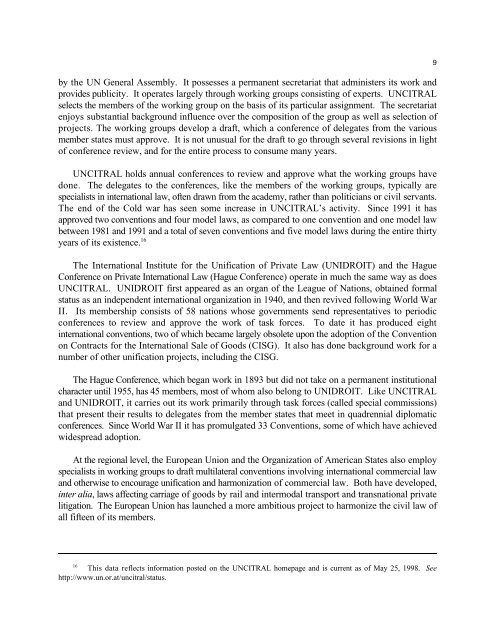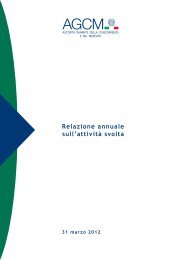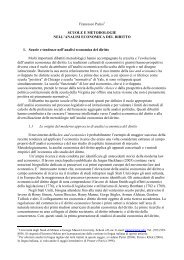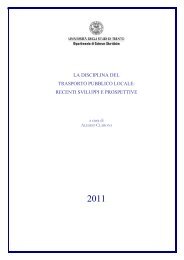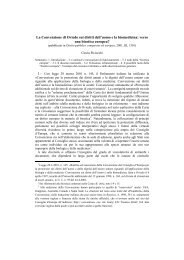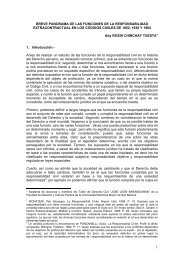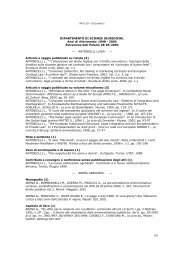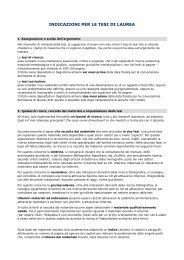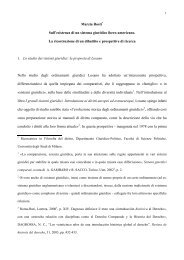The Futility of Unification and Harmonization in International ...
The Futility of Unification and Harmonization in International ...
The Futility of Unification and Harmonization in International ...
You also want an ePaper? Increase the reach of your titles
YUMPU automatically turns print PDFs into web optimized ePapers that Google loves.
y the UN General Assembly. It possesses a permanent secretariat that adm<strong>in</strong>isters its work <strong>and</strong>provides publicity. It operates largely through work<strong>in</strong>g groups consist<strong>in</strong>g <strong>of</strong> experts. UNCITRALselects the members <strong>of</strong> the work<strong>in</strong>g group on the basis <strong>of</strong> its particular assignment. <strong>The</strong> secretariatenjoys substantial background <strong>in</strong>fluence over the composition <strong>of</strong> the group as well as selection <strong>of</strong>projects. <strong>The</strong> work<strong>in</strong>g groups develop a draft, which a conference <strong>of</strong> delegates from the variousmember states must approve. It is not unusual for the draft to go through several revisions <strong>in</strong> light<strong>of</strong> conference review, <strong>and</strong> for the entire process to consume many years.UNCITRAL holds annual conferences to review <strong>and</strong> approve what the work<strong>in</strong>g groups havedone. <strong>The</strong> delegates to the conferences, like the members <strong>of</strong> the work<strong>in</strong>g groups, typically arespecialists <strong>in</strong> <strong>in</strong>ternational law, <strong>of</strong>ten drawn from the academy, rather than politicians or civil servants.<strong>The</strong> end <strong>of</strong> the Cold war has seen some <strong>in</strong>crease <strong>in</strong> UNCITRAL’s activity. S<strong>in</strong>ce 1991 it hasapproved two conventions <strong>and</strong> four model laws, as compared to one convention <strong>and</strong> one model lawbetween 1981 <strong>and</strong> 1991 <strong>and</strong> a total <strong>of</strong> seven conventions <strong>and</strong> five model laws dur<strong>in</strong>g the entire thirtyyears <strong>of</strong> its existence. 16<strong>The</strong> <strong>International</strong> Institute for the <strong>Unification</strong> <strong>of</strong> Private Law (UNIDROIT) <strong>and</strong> the HagueConference on Private <strong>International</strong> Law (Hague Conference) operate <strong>in</strong> much the same way as doesUNCITRAL. UNIDROIT first appeared as an organ <strong>of</strong> the League <strong>of</strong> Nations, obta<strong>in</strong>ed formalstatus as an <strong>in</strong>dependent <strong>in</strong>ternational organization <strong>in</strong> 1940, <strong>and</strong> then revived follow<strong>in</strong>g World WarII. Its membership consists <strong>of</strong> 58 nations whose governments send representatives to periodicconferences to review <strong>and</strong> approve the work <strong>of</strong> task forces. To date it has produced eight<strong>in</strong>ternational conventions, two <strong>of</strong> which became largely obsolete upon the adoption <strong>of</strong> the Conventionon Contracts for the <strong>International</strong> Sale <strong>of</strong> Goods (CISG). It also has done background work for anumber <strong>of</strong> other unification projects, <strong>in</strong>clud<strong>in</strong>g the CISG.<strong>The</strong> Hague Conference, which began work <strong>in</strong> 1893 but did not take on a permanent <strong>in</strong>stitutionalcharacter until 1955, has 45 members, most <strong>of</strong> whom also belong to UNIDROIT. Like UNCITRAL<strong>and</strong> UNIDROIT, it carries out its work primarily through task forces (called special commissions)that present their results to delegates from the member states that meet <strong>in</strong> quadrennial diplomaticconferences. S<strong>in</strong>ce World War II it has promulgated 33 Conventions, some <strong>of</strong> which have achievedwidespread adoption.At the regional level, the European Union <strong>and</strong> the Organization <strong>of</strong> American States also employspecialists <strong>in</strong> work<strong>in</strong>g groups to draft multilateral conventions <strong>in</strong>volv<strong>in</strong>g <strong>in</strong>ternational commercial law<strong>and</strong> otherwise to encourage unification <strong>and</strong> harmonization <strong>of</strong> commercial law. Both have developed,<strong>in</strong>ter alia, laws affect<strong>in</strong>g carriage <strong>of</strong> goods by rail <strong>and</strong> <strong>in</strong>termodal transport <strong>and</strong> transnational privatelitigation. <strong>The</strong> European Union has launched a more ambitious project to harmonize the civil law <strong>of</strong>all fifteen <strong>of</strong> its members.916This data reflects <strong>in</strong>formation posted on the UNCITRAL homepage <strong>and</strong> is current as <strong>of</strong> May 25, 1998. Seehttp://www.un.or.at/uncitral/status.


